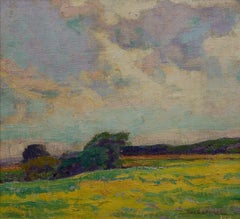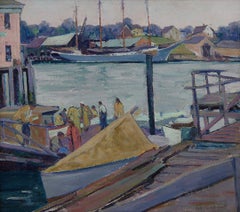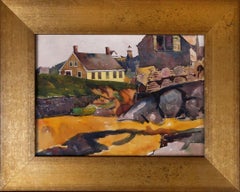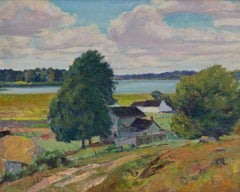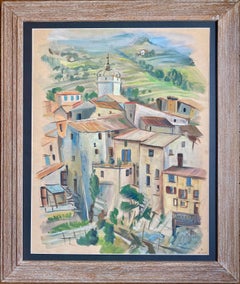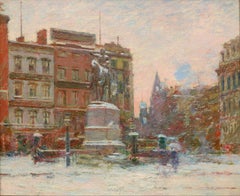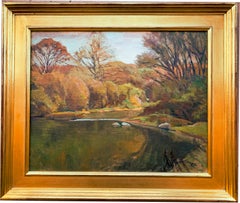George G. Adomeit Art
American, 1879-1967
A major painter of American scene subjects, George Adomeit was born in Memel, Germany, and came to Cleveland at the age of four with his family. Encouraged by his family, he set up a drawing studio in his home at the age of eight. Adomeit took art lessons throughout his high school years and, after winning a full scholarship to the Cleveland School of Art, chose instead a three-year apprenticeship in lithography. He was the cofounder of the Caxton Company, an engraving and commercial art firm that gained national acclaim.
Adomeit's talent for drawing led him to formal training at the Cleveland School of Art, where he graduated in 1911. His first exhibition was of work done outdoors in Zoar, Ohio, a popular plein air painting locale for artists interested in rural subject matter. His imagery was inspired by many other locations, including the Cleveland area and vacation spots such as Cape Cod, Monhegan Island off the coast of Maine, and sites in Mexico, Canada and Brazil.
Adomeit gained a national reputation by showing in exhibitions at the Pennsylvania Academy of Fine Arts, the Toledo Museum of Art, the Corcoran Gallery of Art, and many museums in the East and Midwest. After his retirement from the Caxton Company in 1956, Adomeit continued to travel, paint and exhibit.(Biography provided by WOLFS)
to
7
7
2
1
1
Early 20th Century Summer Landscape, Cleveland School Artist
By George Adomeit
Located in Beachwood, OH
George Gustav Adomeit (American, 1879-1967)
Summer Landscape
Oil on canvas board
Signed lower right
13 x 14.25 inches
18.25 x 19.5 inches, framed
A major painter of American scene s...
Category
Early 20th Century American Modern George G. Adomeit Art
Materials
Oil
Boothbay Harbor, Maine Dock Seascape, Early 20th Century, Cleveland School
By George Adomeit
Located in Beachwood, OH
George Gustav Adomeit (American, 1879-1967)
Boothbay Harbor, 1924
Oil on canvas
Signed lower right
15 x 17 inches
20.25 x 22.25 inches, framed
A major painter of American scene subj...
Category
1920s American Modern George G. Adomeit Art
Materials
Oil
Beachside Village, Maine, 20th century landscape watercolor, Cleveland School
By George Adomeit
Located in Beachwood, OH
George Gustav Adomeit (American, 1879-1967)
Beachside Village, Maine
Watercolor on paper
Signed lower right
10 x 14 inches
17.75 x 21.75 inches, framed
A major painter of American ...
Category
Mid-20th Century American Modern George G. Adomeit Art
Materials
Watercolor
Coastal Scene, 20th Century Seascape, Cleveland School Artist
By George Adomeit
Located in Beachwood, OH
George Gustav Adomeit (American, 1879-1967)
Coastal Scene
Oil on canvas
Signed lower left
19 x 23 inches
21.5 x 25.5 inches, framed
A major painter of American scene subjects, Georg...
Category
20th Century American Modern George G. Adomeit Art
Materials
Oil
Ohio Countryside, 20th century farm landscape, Cleveland School Artist
By George Adomeit
Located in Beachwood, OH
George Gustav Adomeit (American, 1879-1967)
Ohio Countryside
Oil on artist's board
16 x 20 inches
21.5 x 25.5 inches, framed
A major painter of American scene subjects, George Adome...
Category
20th Century American Modern George G. Adomeit Art
Materials
Oil
Seascape
By George Adomeit
Located in Fairlawn, OH
Seascape (Off Monhegan, Maine)
Oil on canvas, mounted to board by the artist, c. 1940
Signed: George G. Adomeit lower right
A view of the Maine coas...
Category
20th Century American Impressionist George G. Adomeit Art
Materials
Oil
Farm House, colorful 20th century American scene watercolor
By George Adomeit
Located in Beachwood, OH
George Gustav Adomeit (American, 1879-1967)
Farm House, Chagrin Falls, Ohio
Watercolor on paper
Signed lower right, handwritten artist and title label verso
12.5 x 18.75 inches
18 x 24.5 inches, framed
A major painter of American scene...
Category
20th Century American Realist George G. Adomeit Art
Materials
Watercolor
Related Items
African American Woman artist Mailou Jones Cezannian Cote d'Azur cubist village
Located in Norwich, GB
If you are interested in African American Art and in Women in the Arts, I will certainly not need to introduce Lois Mailou Jones (1905-1988). Often associated with the Harlem Renaiss...
Category
Mid-19th Century American Modern George G. Adomeit Art
Materials
Watercolor, Gouache, Handmade Paper
H 29.93 in W 25.79 in D 1.19 in
Union Square, Winter (Washington Monument)
By Theodore Robinson
Located in New York, NY
As one of the first, and most important, American Impressionists, Theodore Robinson helped to introduce the French style to American artists and audiences.
Category
19th Century American Impressionist George G. Adomeit Art
Materials
Oil
Miner Hillard Milling Company
By George William Sotter
Located in New York, NY
Signed lower right: G.W. Sotter; on verso: MINER HILLARD / MILLING Co.
Category
Mid-20th Century American Impressionist George G. Adomeit Art
Materials
Oil, Board
"Winter Storm, NYC"
By Johann Berthelsen, 1883-1972
Located in Lambertville, NJ
Jim’s of Lambertville Fine Art Gallery is proud to offer this piece by Johann Berthelsen (1883 – 1972).
Born in 1883 in Denmark to artistically inclined parents, Johann Berthelsen would become a widely successful singer, teacher, and painter. After his parents divorced, his mother brought Berthelsen and his siblings with her to the United States in 1890, eventually settling in Wisconsin.
At eighteen, Berthelsen moved to Chicago in the hope of becoming an actor, but a friend at the Chicago Musical College convinced him to audition at his school. Berthelsen received a full scholarship and enrolled at the college, where he was awarded the Gold Medal twice. After graduating, he had an active career traveling across the United States and Canada performing in operas and concerts, before joining the voice faculty at his alma mater in 1910. In 1913, Berthelsen became the voice department director at the Indianapolis Conservatory of Music.
While in Chicago, Berthelsen met the landscape painter, Svend Svendsen...
Category
20th Century American Impressionist George G. Adomeit Art
Materials
Oil, Canvas
Rare Chaim Gross Watercolor Painting Manhattan Skyscrapers Train NYC WPA Artist
By Chaim Gross
Located in Surfside, FL
This appears to be dated 1927. It came in with a piece dated 1929. A very early, rare work.
Framed 22.5 x 18. Image 14.5 x 9
A great New York city street scene with an El train (elevated subway line) and architectural renderings of buildings.
This is a wonderful piece by one of America's most treasured artists, Chaim Gross. Throughout his lifetime Gross has gone through tragedy and a real test of faith however, he has the unique ability to focus and direct his expression to the most joyful and beautiful works of art, such as the present lot. For more than sixty years Chaim Gross's art has expressed optimistic, affirming themes. His acrobats, cyclists, and mothers and children convey joyfulness, exuberance, love, and intimacy. This aspect of his work
remained consistent with his Hasidic heritage, which teaches that "only in his childlike happiness is man nearest to God." He often used his creative abilities to explore and experiment with media. In his artwork he retains an optimistic philosophy, even when facing somber issues such as war, depression, and the Holocaust.
Chaim Gross (March 17, 1904 – May 5, 1991) was an American sculptor and educator.
Gross was born to a Jewish family in Austrian Galicia, in the village of Wolowa (now known as Mezhgorye, Ukraine), in the Carpathian Mountains. In 1911, his family moved to Kolomyia (which was annexed into the Ukrainian USSR in 1939 and became part of newly independent Ukraine in 1991). When World War I ended, Gross and brother Avrom-Leib went to Budapest to join their older siblings Sarah and Pinkas. Gross applied to and was accepted by the art academy in Budapest and studied under the painter Béla Uitz, though within a year a new regime under Miklos Horthy took over and attempted to expel all Jews and foreigners from the country. After being deported from Hungary, Gross began art studies at the Kunstgewerbeschule in Vienna, Austria shortly before immigrating to the United States in 1921. Gross's studies continued in the United States at the Beaux-Arts Institute of Design, where he studied with Elie Nadelman and others, and at the Art Students League of New York, with Robert Laurent. He also attended the Educational Alliance Art School, studying under Abbo Ostrowsky, at the same time as Moses Soyer and Peter Blume.
In 1926 Gross began teaching at The Educational Alliance, and continued teaching there for the next 50 years. Louise Nevelson was among his students at the Alliance (in 1934), during the time she was transitioning from painting to sculpture. In the late 1920s and early 1930s he exhibited at the Salons of America exhibitions at the Anderson Galleries and, beginning in 1928, at the Whitney Studio Club. In 1929, Gross experimented with printmaking, and created an important group of 15 linocuts and lithographs of landscapes, New York City streets and parks, women in interiors, the circus, and vaudeville. The entire suite is now in the collection of the Philadelphia Museum of Art. Gross returned to the medium of printmaking in the 1960s, and produced approximately 200 works in the medium over the next two decades.
In March 1932 Gross had his first solo exhibition at Gallery 144 in New York City. For a short time they represented Gross, as well as his friends Milton Avery, Moses Soyer, Ahron Ben-Shmuel and others.
Gross was primarily a practitioner of the direct carving method, with the majority of his work being carved from wood. Other direct carvers in early 20th-century American art include William Zorach, Jose de Creeft, and Robert Laurent. Works by Chaim Gross can be found in major museums and private collections throughout the United States, with substantial holdings (27 sculptures) at the Hirshhorn Museum and Sculpture Garden. A key work from this era, now at the Smithsonian American Art Museum, is the 1932 birds-eye maple Acrobatic Performers, which is also only one and one quarter inch thick.
In 1933 Gross joined the government's PWAP (Public Works of Art Project), which transitioned into the WPA (Works Progress Administration), which Gross worked for later in the 1930s. Under these programs Gross taught and demonstrated art, made sculptures that were placed in schools and public colleges, made work for Federal buildings including the Federal Trade Commission Building, and for the France Overseas and Finnish Buildings at the 1939 New York World's Fair. Gross was also recognized during these years with a silver medal at the Exposition universelle de 1937 in Paris, and in 1942, with a purchase prize at the Metropolitan Museum of Art's "Artists for Victory" exhibition for his wood sculpture of famed circus performer Lillian Leitzel.
In 1949 Gross sketched Chaim Weizmann, President of Israel, at several functions in New York City where Weizmann was speaking, Gross completed the bust in bronze later that year. Gross returned to Israel for three months in 1951 (the second of many trips there in the postwar years) to paint a series of 40 watercolors of life in various cities. This series was exhibited at the Jewish Museum (Manhattan) in 1953.
In the 1950s Gross began to make more bronze sculptures alongside his wood and stone pieces, and in 1957 and 1959 he traveled to Rome to work with famed bronze foundries including the Nicci foundry. At the end of the decade Gross was working primarily in bronze which allowed him to create open forms, large-scale works and of course, multiple casts. Gross's large-scale bronze The Family, donated to New York City in 1991 in honor of Mayor Ed Koch, and installed at the Bleecker Street Park at 11th street, is now a fixture of Greenwich Village. In 1959, a survey of Gross's sculpture in wood, stone, and bronze was featured in the exhibit Four American Expressionists curated by Lloyd Goodrich at the Whitney Museum of American Art, with work by Abraham Rattner, Doris Caesar, and Karl Knaths. In 1976, a selection from Gross's important collection of historic African sculpture, formed since the late 1930s, was exhibited at the Worcester Art Museum in the show The Sculptor's Eye: The African Art Collection of Mr. and Mrs. Chaim Gross. Gross was elected into the National Academy of Design as an Associate member, and became a full Academician in 1981. In 1984, he was inducted into the American Academy of Arts and Letters, with Jacob Lawrence and Lukas Foss. In the fall of 1991, Allen Ginsberg gave an important tribute to Gross at the American Academy of Arts and Letters, which is published in their Proceedings. In 1994, Forum Gallery, which now represents the Chaim Gross estate, held a memorial exhibition featuring a sixty-year survey of Gross's work.
Gross was a professor of printmaking and sculpture at both the Educational Alliance and the New School for Social Research in New York City, as well as at the Brooklyn Museum Art School, the MoMA art school, the Art Student's League and the New Art School (which Gross ran briefly with Alexander Dobkin...
Category
Mid-20th Century American Modern George G. Adomeit Art
Materials
Paper, Watercolor
The Fly Fisherman, Figurative Landscape Watercolor
By Harvey Eckert
Located in Soquel, CA
Delicate depiction of a fly fisherman in the rain by Harvey Eckert (American, 1946-2018). This highly detailed landscape watercolor depicts a man fishing in the rain, wading into the water as he smokes a pipe under a tree.
Signed and dated in the lower right corner.
Presented in a wood frame with a double mat and anti-glare glass.
A check from the original purchase is attached to verso (blurred for privacy).
Image size: 14"H x 18"W
Harvey Eckert (American, 1946-2018) was an American artist from Kansas. He attended Colby Community College, Hays Emporia State and graduated from Wichita University with two degrees. While living in Montana, he was employed by Bob Wards, Fran Johnson’s Sporting Goods and Cashell Engineers as a surveyor and draftsman. Eckert illustrated three books, Caddisflies by the late Gary LaFontaine, Montana Trout Flies and The Master Fly Weaver by the late George Grant. He did illustrations for the following publications: Montana Outdoors, Colorado Streamside, The River Rat published by Trout Unlimited, Fly Fisherman, Rod and Reel...
Category
1980s American Modern George G. Adomeit Art
Materials
Watercolor, Paper
H 19.75 in W 23.75 in D 0.75 in
"In Port"
By Edward Willis Redfield
Located in Lambertville, NJ
Jim’s of Lambertville is proud to offer this artwork by:
Edward Willis Redfield (1869 - 1965)
Edward W. Redfield was born in Bridgeville, Delaware, moving to Philadelphia as a young child. Determined to be an artist from an early age, he studied at the Spring Garden Institute and the Franklin Institute before entering the Pennsylvania Academy from 1887 to 1889, where he studied under Thomas Anshutz, James Kelly, and Thomas Hovenden. Along with his friend and fellow artist, Robert Henri, he traveled abroad in 1889 and studied at the Academie Julian in Paris under William Bouguereau and Tony Robert-Fleury. While in France, Redfield met Elise Deligant, the daughter of an innkeeper, and married in London in 1893.
Upon his return to the United States, Redfield and his wife settled in Glenside, Pennsylvania. He remained there until 1898, at which time he moved his family to Center Bridge, a town several miles north of New Hope along the Delaware River. Redfield painted prolifically in the 1890s but it was not until the beginning of the twentieth century that he would develop the bold impressionist style that defined his career. As Redfield’s international reputation spread, many young artists gravitated to New Hope as he was a great inspiration and an iconic role model. Edward Redfield remained in Center Bridge throughout his long life, fathering his six children there.
Around 1905 and 1906, Redfield’s style was coming into its own, employing thick vigorous brush strokes tightly woven and layered with a multitude of colors. These large plein-air canvases define the essence of Pennsylvania Impressionism. By 1907, Redfield had perfected his craft and, from this point forward, was creating some of his finest work.
Redfield would once again return to France where he painted a small but important body of work between 1907 and 1908. While there, he received an Honorable Mention from the Paris Salon for one of these canvases. In 1910 he was awarded a Gold Medal at the prestigious Buenos Aires Exposition and at the Panama-Pacific Exposition of 1915 in San Francisco, an entire gallery was dedicated for twenty-one of his paintings.
Since Redfield painted for Exhibition with the intent to win medals, his best effort often went into his larger paintings. Although he also painted many fine smaller pictures, virtually all of his works were of major award-winning canvas sizes of 38x50 or 50x56 inches. If one were to assign a period of Redfield’s work that was representative of his “best period”, it would have to be from 1907 to 1925. Although he was capable of creating masterpieces though the late 1940s, his style fully matured by 1907 and most work from then through the early twenties was of consistently high quality. In the later 1920s and through the 1930s and 1940s, he was like most other great artists, creating some paintings that were superb examples and others that were of more ordinary quality.
Redfield earned an international reputation at a young age, known for accurately recording nature with his canvases and painting virtually all of his work outdoors; Redfield was one of a rare breed. He was regarded as the pioneer of impressionist winter landscape painting in America, having few if any equals. Redfield spent summers in Maine, first at Boothbay Harbor and beginning in the 1920s, on Monhegan Island. There he painted colorful marine and coastal scenes as well as the island’s landscape and fishing shacks. He remained active painting and making Windsor style furniture...
Category
Early 1900s American Impressionist George G. Adomeit Art
Materials
Canvas, Oil
Into the Woods - China Ink and Watercolor by G. Kayser - 1948
Located in Roma, IT
Into the Woods is an original modern artwork realized by the French artist Gabrielle Kayser in 1948.
Original watercolored and china ink on paper.
Hand-signed and dated by the ar...
Category
1940s Modern George G. Adomeit Art
Materials
Watercolor, Ink
H 11.62 in W 8.47 in D 0.08 in
Six O'Clock
Located in Los Angeles, CA
Six O-Clock, c. 1942, oil on canvas, 30 x 20 inches, signed and titled several times verso of frame and stretcher (perhaps by another hand), marked “Rehn” several times on frame (for the Frank K. M. Rehn Galleries in New York City, who represented Craig at the time); Exhibited: 1) 18th Biennial Exhibition of Contemporary American Oil Paintings from March 21 to May 2, 1943 at The Corcoran Gallery of Art in Washington, D.C. #87, original price $450 (per catalog) (exhibition label verso), 2) Craig’s one-man show at the Frank K. M. Rehn Galleries, New York City, from October 26 to November 14, 1942, #10 (original price listed as $350); and 3) Exhibition of thirty paintings sponsored by the Harrisburg Art Association at the State Museum of Pennsylvania in Harrisburg in March, 1944 (concerning this exhibit, Penelope Redd of The Evening News (Harrisburg, Pennsylvania) wrote: “Other paintings that have overtones of superrealism inherent in the subjects include Tom Craig’s California nocturne, ‘Six O’Clock,’ two figures moving through the twilight . . . .” March 6, 1944, p. 13); another label verso from The Museum of Art of Toledo (Ohio): original frame: Provenance includes George Stern Gallery, Los Angeles, CA
About the Painting
Long before Chris Burden’s iconic installation outside of the Los Angeles County Museum of Art, Urban Light, another artist, Tom Craig, made Southern California streetlights the subject of one of his early 1940s paintings. Consisting of dozens of recycled streetlights from the 1920s and 1930s forming a classical colonnade at the museum’s entrance, Burden’s Urban Light has become a symbol of Los Angeles. For Burden, the streetlights represent what constitutes an advanced society, something “safe after dark and beautiful to behold.” It seems that Craig is playing on the same theme in Six O-Clock. Although we see two hunched figures trudging along the sidewalk at the end of a long day, the real stars of this painting are the streetlights which brighten the twilight and silhouette another iconic symbol of Los Angeles, the palm trees in the distance. Mountains in the background and the distant view of a suburban neighborhood join the streetlights and palm trees as classic subject matter for a California Scene painting, but Craig gives us a twist by depicting the scene not as a sun-drenched natural expanse. Rather, Craig uses thin layers of oil paint, mimicking the watercolor technique for which he is most famous, to show us the twinkling beauty of manmade light and the safety it affords. Although Southern California is a land of natural wonders, the interventions of humanity are already everywhere in Los Angeles and as one critic noted, the resulting painting has an air of “superrealism.”
About the Artist
Thomas Theodore Craig was a well-known fixture in the Southern California art scene. He was born in Upland California. Craig graduated with a degree in botany from Pomona College and studied painting at Pamona and the Chouinard Art School with Stanton MacDonald-Wright and Barse Miller among others. He became close friends with fellow artist Milford Zornes...
Category
1940s American Modern George G. Adomeit Art
Materials
Canvas, Oil
"Times Square" Mid 20th Century 1937 Modernism Broadway Drawing NYC Cityscape
Located in New York, NY
"Times Square" Mid 20th Century 1937 Modernism Broadway Drawing NYC Cityscape
Philip Goodwin (20th Century) "Times Square," 23 ½ x 17 ¼ inches. Gouache...
Category
1930s American Modern George G. Adomeit Art
Materials
Gouache, Paper
Simka Simkhovitch WPA Artist Oil Painting Gouache American Modernist Powerline
By Simka Simkhovitch
Located in Surfside, FL
Simka Simkhovitch (Russian/American 1893 - 1949)
This came with a small grouping from the artist's family, some were hand signed some were not.
These were studies for larger paintings.
Simka Simkhovitch (Симха Файбусович Симхович) (aka Simka Faibusovich Simkhovich) (Novozybkov, Russia May 21, 1885 O.S./June 2, 1885 N.S.—Greenwich, Connecticut February 25, 1949) was a Ukrainian-Russian Jewish artist and immigrant to the United States. He painted theater scenery in his early career and then had several showings in galleries in New York City. Winning Works Progress Administration (WPA) commissions in the 1930s, he completed murals for the post offices in Jackson, Mississippi and Beaufort, North Carolina. His works are in the permanent collections of the Dallas Museum of Art, the National Museum of American Art and the Whitney Museum of American Art. Born outside Kyiv (Petrograd Ukraine) into a Jewish family who owned a small department store. During a severe case of measles when he was seven, Simcha Simchovitch sketched the views outside his window and decided to become an artist, over his father's objections. Beginning in 1905, he studied at the Grekov Odessa Art School and upon completion of his studies in 1911 received a recommendation to be admitted to the Imperial Academy of Arts. Though he enrolled to begin classes in architecture, painting, and sculpture at the Imperial Academy, he was dropped from the school roster in December because of the quota on the number of Jewish students and drafted into the army. Simchovitch served as a private in the 175th Infantry Regiment Baturyn [ru] until his demobilization in 1912. Re-enrolling in the Imperial Academy, he audited classes.
Simka Simkhovitch exhibited paintings and sculptures in 1918 as part of an exhibition of Jewish artists and in 1919 placed 1st in the competition "The Great Russian Revolution" with a painting called "Russian Revolution" which was hung in the State Museum of Revolution. In 1922, Simkha Simkhovitch exhibited at the International Book Fair in Florence (Italian: Fiera Internazionale del Libro di Firenze). In 1924, Simkhovitch came to the United States to make illustrations for Soviet textbooks and decided to immigrate instead. Initially he supported himself by doing commercial art and a few portrait commissions. In 1927, he was hired to paint a screen for a scene in the play "The Command to Love" by Fritz Gottwald and Rudolph Lothar which was playing at the Longacre Theatre on Broadway. Art dealers began clamoring for the screen and Simkhovitch began a career as a screen painter for the theater. Catching the attention of the screenwriter, Ernest Pascal, he worked as an illustrator for Pascal, who then introduced him to gallery owner, Marie Sterner. Simkhovitch's works appeared at the Marie Sterner Gallery beginning with a 1927 exhibit and were repeated the following year. Simkhovitch had an exhibit in 1929 at Sterner's on circus paintings. In 1931, he held a showing of works at the Helen Hackett Gallery, in New York City and later that same year he was one of the featured artists of a special exhibit in San Francisco at the California Palace of the Legion of Honor in Lincoln Park. The exhibit was coordinated by Marie Sterner and included four watercolors, including one titled "Nudes". He is of the generation of Russian Soviet artists such as Isaac Pailes, Serge Charchoune, Marc Chagall, Chana Orloff, Isaac Ilyich Levitan, and Ossip Zadkine.
In 1936, Simkhovitch was selected to complete the mural for the WPA Post office project in Jackson, Mississippi. The mural was hung in the post office and courthouse in 1938 depicted a plantation theme. Painted on the wall behind the judge’s bench, “Pursuits of Life in Mississippi”, a depiction of black workers engaged in manual labor amid scenes of white professionals and socialites, was eventually covered over in later years during renovations due to its stereotypical African American imagery. Simka painted what he thought was typical of Jackson. His impression of pre-civil rights Mississippi was evidently Greek Revival column houses, weeping willow trees, working class families, and the oppression of African Americans. He painted African American men picking cotton, while a white man took account of the harvest and a white judge advised a white family, calling it Pursuits of Life in Mississippi.
Though clearly endorsed by the government and initially generally well-received, the mural soon raised concerns with locals as the climate toward racial segregation began to change. The main concern was whether depictions that show African Americans in subjugated societal roles should be featured in a courtroom. The following year, his painting "Holiday" won praise at an exhibition in Lincoln, Nebraska. In 1940, Simkhovitch's second WPA post office project was completed when four murals, "The Cape Lookout Lighthouse and the Orville W. Mail Boat", "The Wreck of the Crissie Wright", "Sand Ponies" and "Canada Geese" were installed in Beaufort, North Carolina. The works were commissioned in 1938 and did not generate the controversy that the Jackson mural had. The main mural is "The Wreck of the Crissie Wright" and depicts a shipwreck which had occurred in Beaufort in 1866. "The Cape Lookout Lighthouse and the Orville W. Mail Boat" depicted the lighthouse built in 1859 and the mail boat that was running mail during the time which Simkhovitch was there. The boat ran mail for the area until 1957. "Sand Ponies" shows the wild horses common to the North Carolina barrier islands and "Canada Geese" showed the importance of hunting and fishing in the area. All four murals were restored in the 1990s by Elisabeth Speight, daughter of two other WPA muralists, Francis Speight...
Category
1930s American Modern George G. Adomeit Art
Materials
Gouache, Oil, Board
"Forest Strongholds"
By John F. Carlson
Located in Lambertville, NJ
Signed lower right. Complemented by a hand carved and gilt frame.
Exhibited at the National Academy of Design, 1928
Category
20th Century American Impressionist George G. Adomeit Art
Materials
Canvas, Oil
Previously Available Items
"Bend Along the Chagrin" George Gustav Adomeit (American 1898-1952)
By George Adomeit
Located in SANTA FE, NM
“Bend Along the Chagrin”
George Gustav Adomeit
(American 1879-1964) circa 1930's
Oil on canvas board
16 x 20 inches
A major painter of American scene subjects, George Adomeit was ...
Category
1930s American Realist George G. Adomeit Art
Materials
Canvas, Oil, Board
H 21 in W 25 in D 2.5 in
George G. Adomeit art for sale on 1stDibs.
Find a wide variety of authentic George G. Adomeit art available for sale on 1stDibs. Customers who are interested in this artist might also find the work of Robert Noel Blair, William Harnden, and Alfred Wands.
